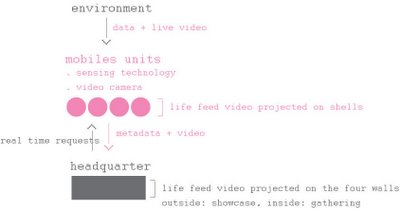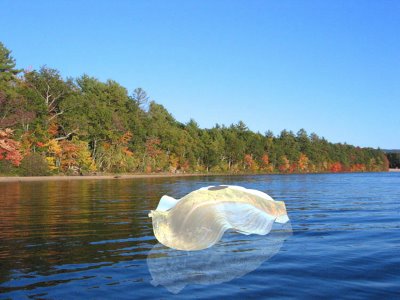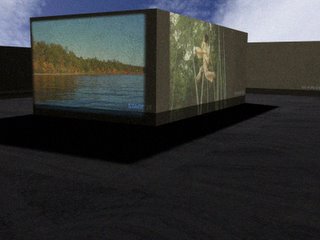If you’re new here, you may want to subscribe to my RSS feed to receive the latest Architectradure’s articles in your reader or via email. Thanks for visiting!
Category: design
-
05DecModular electronic coolness!
If you’re new here, you may want to subscribe to my RSS feed to receive the latest Architectradure’s articles in your reader or via email. Thanks for visiting!
Another really cool project from fellow MIT Media Lab friend Michael Rosenblatt. Modular electronic blocks to make things that move and sense, with various level of difficulty. I can’t wait to try the kit with my daughters 😉 Congrats to the team!!
It is on kickstarter, but be quick, you can get the early first kit
Here is the video
-
18OctArt & Craftmanship
If you’re new here, you may want to subscribe to my RSS feed to receive the latest Architectradure’s articles in your reader or via email. Thanks for visiting!
Discussion about Paz, Octavio, Seeing and Using: Art and Craftsmanship, from: Convergences: essays on art and literature. 1st ed. San Diego: Harcourt Brace Jovanovich, c1987.’
They are handsome because they are useful’ is to me the most stimulating sentence from Paz’s article and it engages me to consider at least two main points. First his definition of beauty and its interconnection to the aesthetic preoccupations of the 18th century, time when the industry has influenced the Arts. Second his position towards Art, Critical Art, Design and Critical Design to finally offer the notion of ‘useful beauty from craftmanship’ which to me echos with Simondon’s thesis on the mode of existence of technical objects.
Emmanuel Kant has written on the aesthetic questions of the 18th century and founded the modern conception of Art by distinguishing artistic beauty from natural beauty. ‘Art does not want to represent a beautiful thing, but to beautifully respresent a thing’. In the18th century, the artist is distinguised from the craftman and Art usually means ‘fine arts’. This event can be explained by industrial production that is founded on a technic and that is more and more couscious of its rules by opposition to the craftman ways of producing where the talent and ingenuosity of the worker (especially in craft work) does not essentially differ from the artistic way of producing. Paz’s description of beauty in craftmanship and his interconnection to Art and Design made me recognize some foundations from Kant and its notion of Art. In Kant’s notion of Art, in a way differently than Hegel, there is no experience of the beautiful in Art. Art is a sub-category of the experience of the beautiful compared to the natural beautiful, and in that way Kant distinguishes the beautiful, good and natural. For Kant, the sentibility is an unsuffisant source of knowledge, it is blind. Sensation is material, the need for knowledge is useful. Then sensation is a source of knowledge but insuffisant. By this Kant has twisted the analysis of Art toward the ability to judge and to be interested in the aesthetic cousciousness.
So when Paz discusses in his introduction the beauty inseparable from its function, it implies an incouscious judgement of the usefulness of the object which directly echoes Kant’s position, but gives enough room to position Duchamp’s radical approach to Art always questionning the meaning of the object without directly contemplating.
Paz mentions that we are unable to associate beauty and usefulness. This comment is very key to me as it directly connects with the thesis of Simondon about the mode of existence of technical objects.In 1958, Simondon argued about the necessity for the individuals to defend themselves against the technical object to appropriate its aesthetic dimension. In fact, the existence of a human reality in the technical object being denied, only the aesthetic object seems to transmit human values. For the popular culture, the technical object has a function but does not express a concept. More specifically, individuals protect themselves against the technical object by reducing it to the status of being useful, and at the same time, paradoxically, they mystify the technological object by wanting it to be evil, powerful and dangerous e.g. Fritz Lang’s female robot character, Metropolis, 1927. It seems that this artificial being that humans create, they are afraid of, and either accuse it of destroying their lives or of only being a useful object without any aesthetic characteristics. As much as Roland Barthes tells us that the status of photography has changed from being purely technical, to being perceived as art, to finally modify the notion of art itself into a concept, e.g. Marcel Duchamp’s art works, it seems there is still an unjustified hierarchy among technical objects depending on their more or less common points with the artistic sphere. Simondon has denounced this unjustified unbalanced between technical and aesthetic in the meaning sphere. However, the popular culture seems to work by oppositions: how could it justify a possible insertion of the technical into the meaning sphere while it is through this lack of knowledge that is can justify the ‘raison d’être’ of the aesthetic sphere?
Paz’s statement of beauty in useful objects is also a way to find useful objects that we are emotionnally connected to: there is a story, there is a meaning. We can create a story by using the objects or imagining its use and by this connecting to the ‘new’ object. The things are then pleasing. Paz mentions that industrial design tends to be impersonal, then it made me wander about this movment of affective design. Interestingly, industrial objects have lost their aura by being demultiplied according to Paz, however objects have been industrially designed to be affective and useful (Norman, 2004), and by this the process that Paz is describing has been twisted.
Finally his position toward technology is the position of the artist painter toward the photography at its emergence. In response to Paz accusation of technology to be negative, we could say that in our ‘open market’ world, thanks to technology, carpenters in Russia can export their skills in the USA and make it possible to average the salary of other carpenters in the world, and by this not only reinforcing the use of craftwork but also diminushing the unbalance between lifestyles in various countries.
-
18OctMobile homes for emergency needs
If you’re new here, you may want to subscribe to my RSS feed to receive the latest Architectradure’s articles in your reader or via email. Thanks for visiting!
I was just chatting with my roommate Lauren about emergency needs after a housing disaster.
What if the population in shock could have access to an immediate home? What if the solution were carefully designed by the local community with the essential means for comfort ? Could this bring them away from the drama? What if these new form of housing were mobile and as such, easily and quickly transportable to arrive in a timely fashion. An instant support. Even though the ideal scenario for this type of emergency situation lies in prevention, what if we could offer a quick fix?
It seems some designers have thought about all this in the form of an inflatable home made of concrete. More info ->here<-
Architecture & Interiors: Inflatable Concrete, Flexible long-term shelters for disaster relief by Peter Brewin and William Crawford at RCA
All the materials to create a robust and durable concrete shelter for disaster relief are combined within a plastic sack.The sacks can be easily transported to the necessary location. Water is added to the sack on site and the plastic inner can then be inflated to create a shelter. The concrete mix covering the inner sets in 4 hours leaving a structure that has a 15 year life-span, keeping cool during the day and retaining heat through the night.
 Posted by Cati Vaucelle @ Architectradure
Posted by Cati Vaucelle @ Architectradure
…………………………………………………………………………………
Blog Jouons Blog Maison
Blog Maison  Blog Passion
Blog Passion 
-
25OctFrom Nokia to Vertu
If you’re new here, you may want to subscribe to my RSS feed to receive the latest Architectradure’s articles in your reader or via email. Thanks for visiting!
Nokia, from cell phone manufacturer to …
Nokia has developped 24000 dollars high end luxury phones … vertu
It raises the design aspect, it is hand craft like a high hand brand. The idea here is to propose the newest material and a taylored service, same idea than Gucci, you buy a Gucci because you try to reach the high end.‘Vertu was born from an obsession to create a personal communication instrument that deployed craftmanship and technology in a way that had never been achieved before’
on Vertu’s website
From the product design, GSD course 2315
-
25OctFrom Nokia to Vertu
If you’re new here, you may want to subscribe to my RSS feed to receive the latest Architectradure’s articles in your reader or via email. Thanks for visiting!
Nokia, from cell phone manufacturer to …
Nokia has developped 24000 dollars high end luxury phones … vertu
It raises the design aspect, it is hand craft like a high hand brand. The idea here is to propose the newest material and a taylored service, same idea than Gucci, you buy a Gucci because you try to reach the high end.‘Vertu was born from an obsession to create a personal communication instrument that deployed craftmanship and technology in a way that had never been achieved before’
on Vertu’s website
From the product design, GSD course 2315
-
18NovTouching memories
If you’re new here, you may want to subscribe to my RSS feed to receive the latest Architectradure’s articles in your reader or via email. Thanks for visiting!
Touch is at the heart of intimate relationship. It is also a powerful trigger of past emotions. Touching memories is a system that detects and records a touch by a loved one. Be it a stroke, a pat, a hug, or a rub, the system will store the touch and play it back to you whenever you need it
This project is in its conceptual phase.
By Cati in affective design
-
18NovTouching memories
If you’re new here, you may want to subscribe to my RSS feed to receive the latest Architectradure’s articles in your reader or via email. Thanks for visiting!
Touch is at the heart of intimate relationship. It is also a powerful trigger of past emotions. Touching memories is a system that detects and records a touch by a loved one. Be it a stroke, a pat, a hug, or a rub, the system will store the touch and play it back to you whenever you need it
This project is in its conceptual phase.
By Cati in affective design
-
04DecThe ambient peacock explorer
If you’re new here, you may want to subscribe to my RSS feed to receive the latest Architectradure’s articles in your reader or via email. Thanks for visiting!
The Ambient Peacock Explorer
I developed the Ambient Peacock Explorer as a framework for mobile units to document on their environment and report back to a central hub
I believe that new work in this area can physically substantiate the documentation through tagging, the incorporation of physical communities or other conceptual redefinitions of the environment one seeks to capture.
structure mobiles units + headquarter
mobile units independent from the headquarter
One shell per context of exploration. Shell inflated on top of the structure to indicate where the mobile unit is going.
Context based shells per unit
Water: Jelly Fish Organic Shell
Countryside: Wooden structure
City: Inflatable Concrete
Air: Blimpheadquater
Is composed of four gathering areas: the air, the countryside, the city and the water area, a studio and an editing room. Each wall receives life feed from the mobile units based on each unit context. Environmental data from sensing mobile units are also projected on the walls as meta information. The headquarter itself retro-project on its roof the life feed of its environment and on the external walls displays the video from mobiles units. The production center also invites to discuss the documentaries and environmental issues and by that is also a showcase building.technology specs
Live feed video camera from mobile units to headquarter. Each mobile unit is composed of one video camera connected via satellite to the headquarter. The life feed video camera is sent to the headquarter and projected onto the contextual area outside wall and inside wall (as part of the cafeteria gathering) area.Video recording and metadata from mobile units to headquarter. Each mobile unit documents by recording visual environmental elements and use sensing technologies to combine video recorded and environmental data for later post production video retrieval. For instance GPS technology for location data retrieval, temperature, wind information and so forth. The production companies will retrieve video recordings of the mobile units and metadata associated to them.
Live feed video camera from mobile units onto mobile units. Each mobile unit would retro project their life feed footage onto their semi-transparent fabric structure to melt within its environment.
Headquarter data exchange with mobile units. Information and request coming from headquarter to define what to explore by real time exchange video footage. Scenario: if the mobile unit is in the air and crosses a bird migration, the headquarter could visualize it and request more detailed footage or more sensing environmental data coming from the bird migration.
communication system diagram

visual scenario of the ambient peacock explorer
the blimp the air mobile unit.
The shell inflated on top of the structure indicates the mobile unit is going to document from above and in the air.
the mobile unit common to all contexts is controlled by two people. It has real time contact with the headquarter via satellite. One person controls the mobile unit and one gathers data, exchanges information, and prepare the unit to its environmental use. The unit consists of the inflatable blimp on top, the floatation device including the organic shell at the bottom, a projector to display environmental data inside each shell.
the mobile unit going into water.
The compressor is used for the floatation device and an organic semi transparent shell is added around the structure. The environmental life feed video is projected on the shell. The mobile unit is waterproof.
external view of the headquarter as a showcase.
Four walls: the air, the countryside, the city and the water. Each wall receives life feed from the mobile units based on each unit context.The Ambient peacock explorer is a project I made with Philip Vriend for the Kinetic Architecture class, Assignment 2, November 2005.
By Cati in kinetic architecture
-
11Deccities: 10 lines. approaches to cities and open territory design
If you’re new here, you may want to subscribe to my RSS feed to receive the latest Architectradure’s articles in your reader or via email. Thanks for visiting!

From Sept 2005 until now I have created the graphic design for the exhibition: cities: 10 lines. approaches to cities and open territoty design currated by joan busquets and felipe correa at harvard graduate school of design.By Cati in ‘on the side’ work





